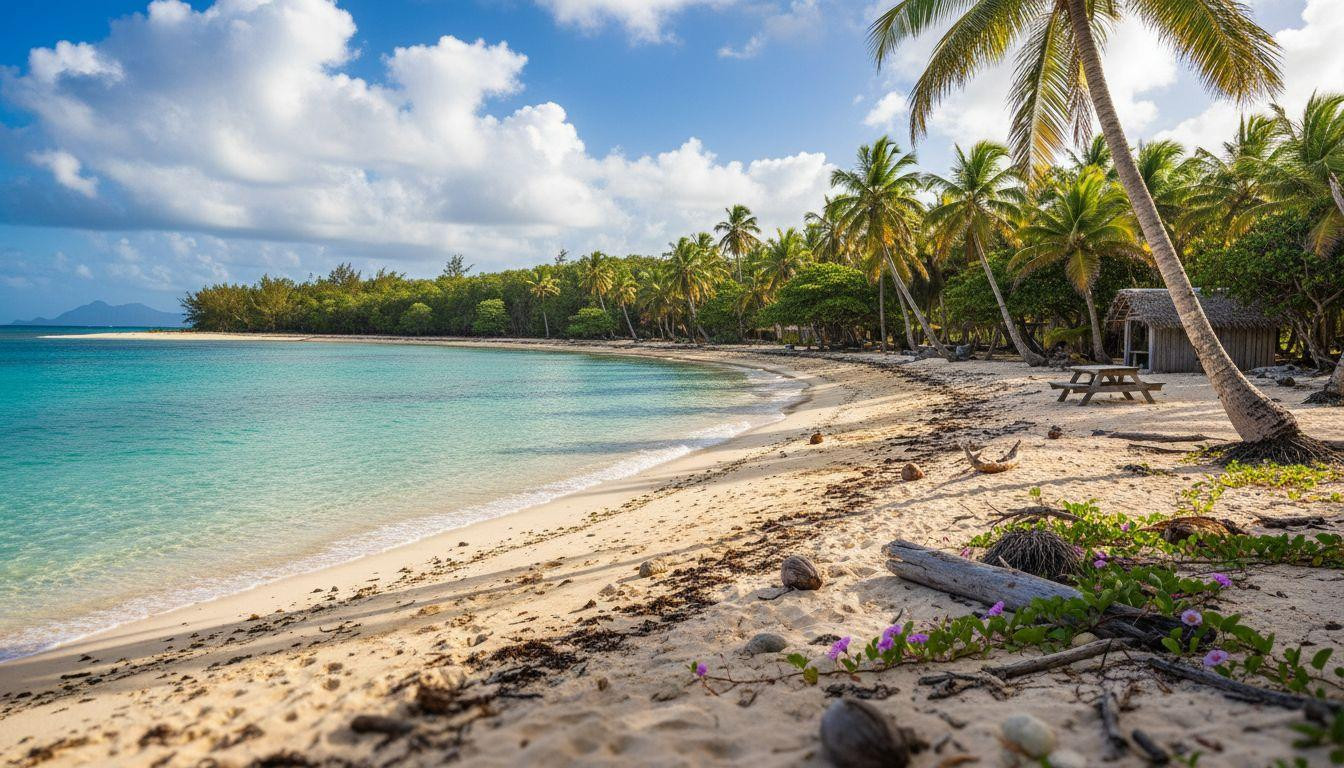This wild arc of sand defies every Caribbean beach expectation. Salines Beach stretches nearly a mile along Martinique’s southern coast, yet remains gloriously undeveloped despite welcoming nearly one million visitors annually. Where Grace Bay boasts towering resorts and St. Barts commands $200 beach club minimums, this turquoise paradise stays authentically free.
Where wild sand meets turquoise calm
The 45-minute drive south from Fort-de-France Airport reveals Martinique’s secret. Route Nationale 2 winds through sugar cane fields before depositing visitors at a parking area tucked beneath coconut palms. No grand entrance gates or resort signage mark this arrival.
Salines Beach curves in a perfect semi-circle for 1.2 kilometers. The sand shifts from golden-white near the palms to brilliant ivory at the water’s edge. Turquoise water deepens gradually: waist-deep at 150 feet offshore, shoulder-deep at 300 feet.
Coconut groves frame two-thirds of the beach with natural shade. The remaining stretch basks in open Caribbean sun. Behind the palms, mangrove forests create a living buffer zone that has protected this coastline since before Columbus arrived.
What makes this arc different
The visual draw that cameras can’t capture
Six wooden structures serve food and drinks, all built before 2005. No sun loungers line the sand. No jet ski rental kiosks interrupt the view. Natural driftwood and seaweed remain where waves deposit them, supporting a thriving coastal ecosystem.
The absence overwhelms visitors more than any presence could. Unlike Antigua’s developed beaches, Salines offers 65% natural palm shade without a single artificial structure directly on sand.
The cultural element locals protect fiercely
Salt production thrived here from 1760 through the 1920s. Stone evaporation beds still dot the Étang des Salines lagoon behind the beach. When developers proposed hotels in 2010, Sainte-Anne residents formed human chains along the waterline.
Sunday mornings bring multi-generational Martiniquais families by 9 AM. Creole conversations mix with French beneath swaying palms. Local restaurants like Chez Sissy (operating since 1987) close at 4 PM because “this is Martinique, not a theme park.”
The Salines experience
What you’ll actually do
Swimming requires no water shoes on the gentle sand bottom. Snorkeling works best near the southern headland where rocky formations shelter tropical fish. Blue tangs and sergeant majors patrol seagrass beds in crystalline water with 90-foot visibility.
Walking the full 1.2 kilometers takes 18 minutes at a leisurely pace. Compare this to Bequia’s shorter stretches, and Salines offers genuine space for solitude even during peak season.
Leatherback turtles nest here occasionally between March and July. Local conservation efforts documented three nests in 2024, up from one in 2021. The mangrove restoration project launched in 2019 creates better nesting conditions annually.
Local rhythms worth joining
Morning light hits the water at 7 AM with golden intensity. Trade winds peak between 11 AM and 1 PM, perfect for paddleboarding. Afternoon calms arrive by 3 PM, ideal for swimming and snorkeling.
Accras (cod fritters) cost $3 at beachside shacks. Fresh grilled fish runs $18 for generous portions. Unlike Hawaii’s remote beaches, Salines offers authentic Caribbean cuisine steps from turquoise water.
This beach stays wild because
Martinique’s 1983 Coastal Law prohibits construction within 300 feet of high tide lines in designated natural areas. Ramsar Wetland protection (Site #1830 since 2008) covers the adjacent Étang des Salines lagoon and mangrove ecosystem.
Limited parking naturally controls crowds. The 220-vehicle capacity fills by 10 AM on December weekends, but November weekdays see barely 50 cars. No shuttle services or overflow lots exist by design.
While Indonesia offers shallow-water walking, Salines provides the opposite: deep swimming just 100 yards from a completely undeveloped shoreline. This combination grows rarer each Caribbean season.
Your questions about Salines Beach answered
How do I get there without renting a car?
Route 12 buses run from Fort-de-France to Sainte-Anne every 45 minutes, 7 AM-7 PM daily. The $4 fare covers a 55-minute journey. The beach lies 2 miles south of Sainte-Anne’s center, walkable in 35 minutes or $15 by taxi.
When should I visit for the fewest crowds?
Weekday mornings between 7-9 AM offer near-solitude even in high season. November provides the sweet spot: 77°F air, 79°F water, moderate crowds, and 40% lower accommodation rates than December. Avoid weekends year-round when locals rightfully reclaim their beach.
How does it compare to other famous Caribbean beaches?
Salines hosts 200 visitors per 300 feet of beach versus Grace Bay’s 480 per 300 feet. Daily costs average $30 (food, transport, gear) compared to $150+ at St. Barts beach clubs. Water clarity matches the Maldives at 90 feet visibility, but mangrove backing creates unique ecosystem diversity.
Late afternoon light transforms the arc into liquid gold stretching toward distant peaks. Palm shadows lengthen across sand that stays powder-soft beneath bare feet. The last swimmers wade through water warm as bathwater, while fishing boats appear as distant silhouettes against the Caribbean horizon.
